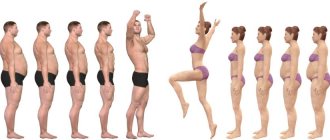It's no secret that excess body weight is very harmful to health. According to research, the most dangerous area to have is belly fat. Because it spreads to the internal organs, forming visceral deposits and disrupting their function. As a result, serious diseases develop, in particular, the heart suffers and blood sugar levels increase.
Different types of figures
Body type plays a big role in the distribution of body fat. It is he who determines where the bulk of the body will be concentrated - below or above.
As a rule, the most common types of shapes are apple and pear. In the first case, fat is deposited mainly on the abdomen, and in the second - on the hips and buttocks.
At a young age, fat deposits are more often localized at the bottom in females and at the top in males. Therefore, among people 30-40 years old, men are more susceptible to cardiovascular and other pathologies. On the contrary, women begin to develop heart disorders after menopause.
That's another fruit
As you know, there are different types of figures. The ideal female figure is an hourglass. The other two types are called "apple" and "pear". In the first “fruit”, fat accumulations are concentrated mainly in the waist area (in this case, the pelvis can be boyishly narrow). But “pears,” on the contrary, have a rather thin waist, and fat reserves envelop the hips and soft parts. The risk of visceral obesity is higher in “apple” people, that is, in people with a plump waist, a large belly and plump sides.
Sports or diet? Scientists explain how to fight obesity
Read more
“Pears” were much luckier. Danish scientists, who observed three thousand women for 10 years, found that ladies with hips of 100 cm and above are healthier than lean, narrow-hipped young ladies. And all thanks to the hormone adiponectin, which is produced by the fat cells of this piquant area and plays a huge role in the prevention of many diseases.
Article on the topic
Longevity diet. How to eat so as not to age longer?
However, how not to add a fly in the ointment here? Regardless of body type and genetics, in women after 40 years of age, the production of female sex hormones decreases, and the likelihood that the volume of visceral adipose tissue will increase increases significantly. In addition, visceral fat grows when leading an unhealthy lifestyle, stress, excess nutrition, and low physical activity.
Healthy lifestyle and nutrition
Regardless of age and gender, people should adhere to proper nutrition and maintain a healthy lifestyle. It is this joint tandem that will ensure overall health of the body and prevent the appearance of fat in the abdominal area.
To do this, you should reconsider your own eating habits. It is important to exclude fast food, semi-finished products, large quantities of sweets, and harmful drinks. And vice versa, enrich your diet with healthy and wholesome foods that contain all the necessary vitamins and minerals for the proper functioning of the body.
It is important to combat physical inactivity. It is recommended to perform simple abdominal exercises daily and start the morning with exercises. Then, based on clinical trials, it is possible to reduce visceral belly fat by about 8% in 8 months. On the contrary, a sedentary lifestyle and poor nutrition leads to an increase in fat deposits at the waist over the same period of time by 9%.
Wide waist: the dangers of belly fat
The main fat reserves are located under the skin and are called subcutaneous fat. As fat mass increases, the body may begin to store fat inside muscle tissue and between the internal organs of the abdominal cavity. This is an unfortunate prospect because this type of fat - visceral or internal fat - can have extremely adverse effects on the entire body. Subcutaneous fat is relatively harmless.
In women of childbearing age, fat tends to accumulate in the subcutaneous depot below the waist, giving the body a characteristic pear-shaped shape. Men are more likely to accumulate fat around the waist, and their body resembles an apple.
Mostly men are predisposed to fullness around the waist, but many women also suffer from it. In the picture, two women are the same weight (and BMI), but one of them has an “apple” body, and the other has a “pear” body.
So, people with an apple body type accumulate toxic visceral fat. Research shows that a wide waist (a sign of abdominal obesity) clearly indicates the presence of visceral fat.
Abdominal obesity is the main cause of a whole bunch of diseases, united by the term “metabolic syndrome”. Typically, abdominal obesity is diagnosed when the waist circumference exceeds 94 cm or more for men and 80 cm for women. Here are other indicators that allow you to make a diagnosis of metabolic syndrome.
- Elevated levels of blood fat (triglycerides). Triglycerides are fats found in the blood. Their high levels lead to an increased risk of cardiovascular diseases. Triglyceride levels greater than 1.7 mmol/L are generally considered a sign of metabolic syndrome.
- Reduced levels of “healthy” cholesterol - high-density lipoprotein (HDL). HDL cholesterol is a special form of cholesterol that is responsible for reducing the risk of heart disease and stroke. A level of this good cholesterol of 0.9 mmol/L or lower is considered critical.
- High blood pressure. High blood pressure leads to heart attacks and strokes. Blood pressure has a higher (systolic) and lower (diastolic) value. Systolic pressure is above 130 mm Hg. Art. and/or diastolic pressure above 85 mm means outside the normal range.
- Elevated blood sugar or pre-diagnosed type 2 diabetes. If the blood sugar level exceeds 5.6 mmol/l, this is a symptom of a disruption in the normal functioning of the body.
If tests have revealed other factors of metabolic syndrome, you should begin an attack on visceral fat and normalize both the psychological and biochemical state of the body.
Impact of stress
Physical inactivity and poor nutrition are considered far from the only factor in a fat waist. Recently, doctors have become more confident that exposure to stress, especially long-term stress, can negatively affect a person’s overall well-being, and can give rise to the development of belly fat.
This is due to the fact that during a stressful situation the body begins to synthesize a large amount of the hormone cortisol. This, in turn, puts the body on high alert. It also contributes to the accumulation of excess volume in the waist area. Many clinical trial experts believe that belly fat is the body's defense against stress and anxiety. Sometimes fat cells break down the hormone, giving the entire body a break from stress.
Measure and Share
Doctors call fat deposited in the area of the stomach, liver, gallbladder, and kidneys visceral.
It plays the role of a shock absorber, protecting internal organs from external influences. But if there is a lot of such fat in the body (more than 10–15% of the total amount of adipose tissue), then expect trouble. Blood circulation worsens, oxygen starvation of organs occurs, and the risk of metabolic syndrome, endocrine disorders, varicose veins and cardiovascular diseases increases. Therefore, it is better to get rid of these unwanted accumulations. Note Unfortunately, the stomach gets better quickly, but losing weight is difficult. The fact is that his fat cells are replete with alpha-2 receptors, which capture excess fat from the blood. But they lack beta receptors, which, when stimulated, can break down fat. However, if you put in the effort, you can solve the problem.
To detect visceral obesity, you can do an expensive bioimpedance analysis of body composition. This will help determine the level of all fat in the body, including hidden fat. Or you can do it differently - just measure your waist. If its volume is less than 88 cm in women and less than 94 cm in men, then the risk of visceral obesity is low. But before you breathe out a sigh of relief, you should also measure your hips and then divide your waist by it. The resulting coefficient for women should be below 0.88, for men - below 0.95.
Slow problem solving
It is important to deal with large waist sizes as early as possible. This will reduce the risk of cardiovascular and other diseases. A healthy lifestyle - proper nutrition and adequate physical activity - will help eliminate external and visceral fat deposits.
In the process of losing weight, the body will make it a priority to get rid of belly fat. By reducing weight by 5-10% of the total weight, you can say goodbye to 30% of the dangerous fat layer.
If the main problem of excess weight is stress, relaxation techniques will be useful.
Scientists have identified the main cause of belly fat
There are many factors that can lead to the accumulation of belly fat - lack of sleep, drinking carbonated drinks, and much more. However, according to American nutritionist Trista Best, the main cause of belly fat is the consumption of certain foods, such as chips, bread and, especially, processed foods.
"These could be regular processed foods or flour-based foods," Best said, adding that the main reason processed foods make it difficult to lose belly fat is because they're mostly made up of refined carbohydrates and sugar. Refined carbohydrates typically have little to no nutritional value, and without fiber, protein, or healthy fats, they are empty calories that can often contribute to the formation and storage of belly fat. Processed foods, high in refined carbohydrates and low in nutrients that slow digestion, are a major source of belly fat, Best says. If you want to get rid of belly fat or prevent it from accumulating, consider cutting back on processed foods, an expert has advised.
A study published in The Journal of Nutrition found that consumption of refined carbohydrates is strongly associated with an increase in waist circumference and the accumulation of belly fat. On the other hand, study participants who consumed an average of three servings of whole grains per day and less refined grains overall had smaller waistlines, lower fasting glucose levels, lower blood pressure and higher levels of "good" HDL cholesterol. “Refined carbohydrates are processed quickly by the body and are easily stored as fat. They are a quick source of energy, but this energy manifests itself in the form of a spike in glucose and an inevitable malfunction of the body,” said Best.
The presence of excess belly fat has a negative impact on the overall health of the body for a number of reasons. Animal fat, also known as visceral fat, poses a health risk because it puts significant strain on the heart and other vital organs, scientists say. It puts the human body at risk for heart disease and stroke, among other chronic conditions. “If fat is allowed to persist, it will form around vital organs and tissues, making weight loss more difficult and also increasing the risk of exacerbation of chronic diseases,” the expert concluded.
Plastic surgery is not a solution in this situation
According to medical research, you won't be able to get rid of visceral belly fat quickly. Based on clinical data, women who had up to 30% of their fat removed during surgery did not achieve recovery. They still have risks of cardiovascular and endocrine diseases. The procedure failed to normalize blood pressure and did not restore the body's ability to respond to insulin. As a result of removing deposits, doctors reduced the number of fat cells, but did not affect their size.
How is the presence of visceral fat determined?
The accumulation of fat in the abdominal area does not mean that it is visceral fat that has been deposited there. Abdominal fat can also be subcutaneous. The only way to accurately measure the amount of visceral fat in the body is with a CT or MRI scan.
However, doctors often rely on general recommendations to estimate the volume of this fat. For example, you can estimate the volume of visceral fat by measuring your waist circumference. Harvard Women's Health Watch writes that women's risk of problems from visceral fat increases if their waist circumference is 35 inches (89 cm) or greater. According to the Harvard T.H. Chan School of Public Health, health problems may occur in men whose waist circumference is 40 inches (102 cm) or greater.
What to eat to lose weight. Special menu for fasting day Read more
How to clean at home
If excess weight is a consequence of illness, then it is unlikely to be possible to get rid of it at home. All other factors that influence fat storage can be eliminated. The complex of measures for body correction includes:
- Proper nutrition. The diet should be selected under the guidance of a doctor; experimenting with your own body is not recommended.
- Physical activity. When working sedentarily, it is necessary to include exercise in your routine.
- Cosmetic procedures, which include massage, body wrap, phyto-barrel, etc.
- Limit alcohol consumption. It is advisable to quit smoking.
These activities must be carried out comprehensively. If you use only one of the methods, a positive result will not be achieved.










